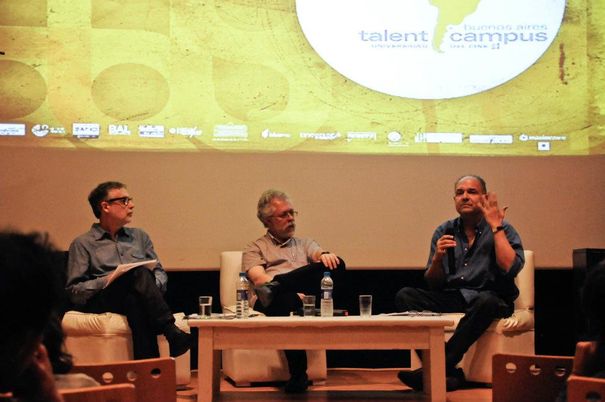Mutoscope and computers
Natalia Barrenha reports from the lecture Found Footage and Editing: Structural Film and History in the Films of Carlos Adriano at the Talent Campus Buenos Aires.

Ismail Xavier, Eduardo Russo and Jorge La Ferla at the Found Footage lecture.
Ismail Xavier, from Brazil, and Eduardo Russo and Jorge La Ferla, from Argentina, great researchers of film in our continent, got together on Monday afternoon at Universidad del Cine's auditorium to once again talk about Film and History, the theme guiding this edition of Buenos Aires Talent Campus.
The lecture, titled Found Footage and Editing: Structural Film and History in the Films of Carlos Adriano, began with Ismail's presentation, who brought with him the film that would trigger the debate: SANTOSCÓPIO=DUMONTAGEM (2008). Ismail was Carlos Adriano's PhD thesis director at USP, Universidad de São Paulo (Brazil). Adriano's thesis included not only theoretical work; he also developed a practical and poetic task.
The Brazilian researcher began his presentation by pointing out the fact that film compilations have always been made, by for example Dziga Vertov, as a way of recovering materials and strking up conversations between history and the past. However, Ismail was interested in talking about the rescue of materials from another point of view, which had its origins in the United States of the 60s and 70s with filmmakers such as Ken Jacobs or Hollis Frampton. The movement was not only about reconquering images; it aimed at making them one's own by developing more poetic experiences, without looking for a story. The point was to incorporate the images; to re-edit them so as to put together another system that dealt with the device, its structure, with film itself. The reflection on its construction then became its actual content. This research on process was named structural film by P. Adams Sitney.
What do we see when we see a film? What does that film make visible? This was one of the aspects structural films dealt with, something modern art had already begun debating: the return to its own origins, to its operative origins. The introduction to structural film was fundamental so as to become familiar with the debate around Carlos Adriano's work, which we watched soon afterwards. Ismail then told the story that led to SANTOSCÓPIO=DUMONTAGEM. Carlos found, at a museum in São Paulo, a machine that not even the local museologists knew what it was about. It was a mutoscope, by which still images gained movement through the mecanic impulse of a handle.
Inside were a series of photos that resulted in a fxed shot of the meeting between Santos Dumont – considered by many as the inventor of the airplane; he flew around the Tour Eiffel with his prototype, years before the Wright Brothers’ machine – and Charles Stewart Rolls - future owner of Rolls Royce - during a trip to London.
Carlos Adriano transformed these 55-second long moving images into one incredible 15-minute short film, by working with different colors, with geometry, speed variations and by making use of two different constructive parameters: the loop and the flicker. The loop refers, firstly, to the loop in Dumont's wonderful invention. It also makes us think about the kinescope and about the circular movements of other pre-cinema devices. The flicker is another typical feature of photechemical cinema. Adriano also emphasizes Santos Dumont's fleeting look towards the camera, which takes us back to the early cinema of attractions. As for the audio treatment, it is inspired by machine sounds, evoking the industrial universe that was bubbling at the time.
Carlos Adriano incubates in his short film a myriad of ideas and make us think about yet another device such as the kaleidoscope, generator of optical illusions, and even about Georges Méliès special effects.
The researchers discussed how both principal constructive parameters in SANTOSCÓPIO=DUMONTAGEM are charcteristic of machines. And even though these have been developed in a computer, they create a dialogue between these two forms of creation as well as establish a reflection on history. Russo - who as a child had the chance to know a fully active mutoscope - observed that this is a form of cinema that looks to the past as well as the future. He also established a discussion about the relationship between interpretation and writing of this type of cinema which deals with found footage, and about the separation and the bringing together of spectator and author, of operator and administrator. La Ferla ended the lecture by comparing Carlos Adriano's experience with those of other filmmakers, such as the interpretations of Alfred Hitchcock's classics (Gus Van Sant’s PSYCHO, Douglas Gordon's 24 HOUR PSYCHO installation), Alain Fleischer's works (MORCEAUX DE CONVERSATIONS AVEC JEAN-LUC GODARD, 2007), as well as those by Woody Vasulka (ART OF MEMORY, 1987). The captivating subject did not leave enough time for the interesting screenings La Ferla had planned, so the Talents promised to watch the videos on YouTube and to continue dicussing the matter later.
(translated by Clara Picasso)

